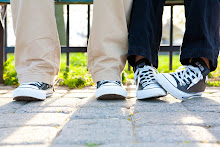Materials
filing cabinet
spray paint (2 colors)
primer (for spray paint)
stencils (which you can make if you want)
sandpaper
gloves (rubber or plastic kind)
face mask (to save your brain cells)
newspaper (to protect surfaces from paint)
Process
- Get a filing cabinet. You do not need to buy a new one. I got mine for free on a freecycle list (freecycle.org), but you can also get them at a Goodwill for under $10. Ask family and friends, too. It seems like lots of people are getting rid of these things because they're old and ugly. That's OK because we can fix that.
- Get stencils. You can easily make stencils by printing whatever you like onto card stock and cutting out the image. I used a free dingbat font for my images. You can also buy stencils if you want. It helps to have the filing cabinet before you make/buy the stencils, so you can plan their placement. I did this the other way around and ended up having kind of awkwardly placed stencils.
- Sand surfaces. Sanding rust off is the most important part to this step, but sanding the old paint helps the new paint adhere, so just basically sand the crap out of the thing.
- Wash surfaces. After you sand it, wash it with a little soap and water. Dirt and stuff stuck on the sides will prevent a good coat of primer/paint to adhere well.
- Remove/cover any hardware you don't want painted. You may want the handles to remain the color they are now, or you may want to paint them the second color (like I did). You can either just cover them with masking tape, or you can remove them entirely. I primed and painted my handles separately. I let the lock be painted the main color.
- Put on gloves and mask. I did not wear these for the primer or base coat, and I really regretted it. The primer and paint are meant to be permanent, so they're really hard to wash off (duh). I also did not wear a mask when I sprayed the base color (even though I bought them), and I had a headache all day afterward. Keep those brain cells. You'll need them to file later.
- Spray with primer. Primer is not entirely necessary, but it helps smooth out the surface and helps the colored paint stick a little better. This is usually white or black. Follow the instructions on the can.
- Spray with base color paint. According to my can, the primer does not have to entirely dry before spraying with colored paint. I would let it dry some, but you don't have to let it sit over night (like I did). **Read this: wait for a relatively warm, not-windy day to do this. It will make your life so much easier. I did not do this. It was very cold (below freezing) and windy (all my paint blew away). If you have a garage, even better. Let this dry completely.
- Prep stencils. Because the force of the paint coming out of the can will blow any edges of a flimsy stencil around, you're going to want to apply rolled masking tape to all of the edges. This way you get a nice clean line instead of a diffused edge - unless that's what you want. Tape the stencils to the surface and tape additional paper around the stencil to cover the entire surface to prevent extra paint from floating around, landing all over the place. This step is pretty important. Look at my final project to see why it's important.
- Spray stencils with second color. It will be important to follow the instructions on the can, but here are some guidelines: Do not spray too close for too long or you will get drips or overly thick paint.
- Remove stencils, tape, etc. Once everything is dry, remove your stencils. Replace the hardware. Add files. You're finished!
The beauty of this project is that if you totally f* it up, you can just redo it later. Also, the possibilities are endless. You could just do a single bright, glossy color to snazz it up. You could do a super shiny, metallic color. You can stencil images, letters, shapes, etc. You could use one color to spray spots, add tape and then spray your main color over that to reveal the color under the tape. My little tutorial is really meant to help give you inspiration to create your own interesting cabinet (or refrigerator, desk, laptop, etc).
Also, don't be too hard on yourself if your final project doesn't turn out exactly the way you planned it. Mine certainly didn't, but I did learn a lot. If I grow to hate my imperfect creation, I can just do it again later (like in the spring when it's warmer). Don't be afraid to just go for it, even if you aren't really sure what you're doing. Do a little internet/library research if you feel really deficient in a particular skill, and then just move forward with reckless abandon. That's also my advice for life in general, by the way.
If you end up doing this tutorial (or something similar), post a picture of your project as a comment (if you can do that). Anyway, post a link to a picture. I'd love to see what kinds of creative mischief you all are up to.
Thanks for reading! Have fun!
If you end up doing this tutorial (or something similar), post a picture of your project as a comment (if you can do that). Anyway, post a link to a picture. I'd love to see what kinds of creative mischief you all are up to.
Thanks for reading! Have fun!








No comments:
Post a Comment